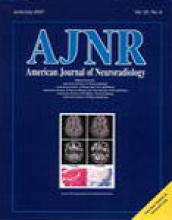Abstract
BACKGROUND AND PURPOSE: Perfusion imaging with dynamic susceptibility contrast MR imaging (DSC-MRI) has been used to evaluate hemodynamic status in patients with symptomatic occlusive cerebrovascular disease. The aim of the present study was to determine the hemodynamic changes occurring in asymptomatic patients with unilateral internal carotid artery (ICA) occlusion by use of DSC-MRI with transcranial Doppler (TCD) measurement of the breath-holding index (BHI).
METHODS: Nine patients with asymptomatic unilateral ICA occlusion underwent DSC-MRI and TCD examination. One patient was excluded from final analysis because of severe movement artifacts. On a separate workstation, regional cerebral blood volume (rCBV), regional cerebral blood flow (rCBF), and regional mean time to peak (rMTT) were calculated on the basis of signal decay rate during the passage of gadolinium bolus through the sampled volume in the territory of the middle cerebral artery. TCD-BHI was calculated in all patients. Six healthy subjects underwent the same MR protocol as the patients.
RESULTS: Compared with control subjects, patients with unilateral ICA occlusions had hemodynamic changes in the ipsilateral hemisphere: rCBF was significantly lower than in controls (P < .01), and r MTT was significantly increased in both white (WM) and gray matter (GM) in the affected side (WM: P < .01; GM: P < .05). No statistically significant difference in rCBV was found in the group of patients (occluded versus contralateral, P < .1) or between the patient and control groups (occluded side versus controls, P < .1). The correlation of rCBV and BHI showed a strong relation of the two variables, showing a decrease of the latter when the former increased.
CONCLUSION: DSC-MRI is a valuable tool for measuring hemodynamic changes in the presence of carotid disease with hemodynamic impairment. In our opinion, hemodynamic changes and efficiency of collateral pathways can be evaluated in occlusive carotid disease by using paired measurement of BHI and DSC-MRI. In the patient group, MR-determined rCBV and TCD-determined BHI showed a significant inverse correlation, suggesting similar significance of the two indices.
- Copyright © American Society of Neuroradiology












